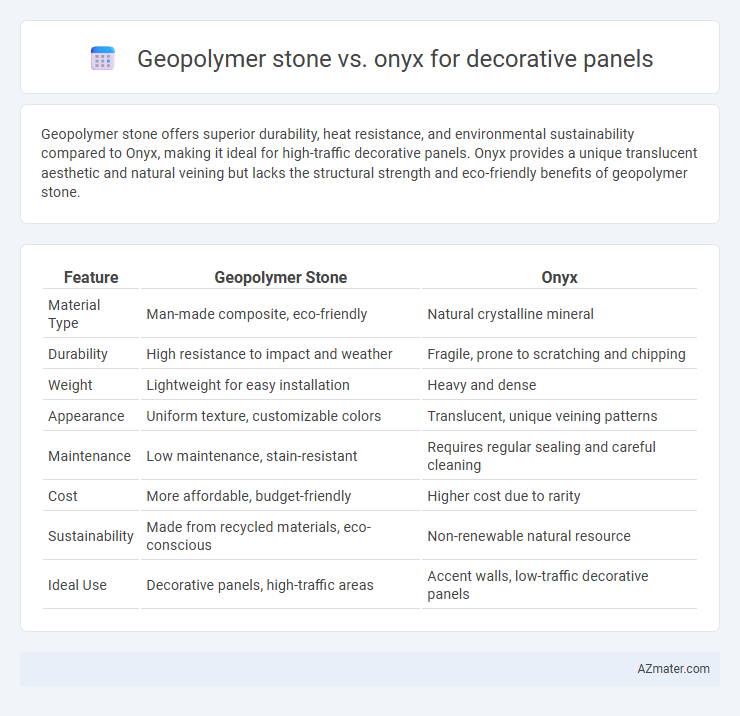Geopolymer stone offers superior durability, heat resistance, and environmental sustainability compared to Onyx, making it ideal for high-traffic decorative panels. Onyx provides a unique translucent aesthetic and natural veining but lacks the structural strength and eco-friendly benefits of geopolymer stone.
Table of Comparison
| Feature | Geopolymer Stone | Onyx |
|---|---|---|
| Material Type | Man-made composite, eco-friendly | Natural crystalline mineral |
| Durability | High resistance to impact and weather | Fragile, prone to scratching and chipping |
| Weight | Lightweight for easy installation | Heavy and dense |
| Appearance | Uniform texture, customizable colors | Translucent, unique veining patterns |
| Maintenance | Low maintenance, stain-resistant | Requires regular sealing and careful cleaning |
| Cost | More affordable, budget-friendly | Higher cost due to rarity |
| Sustainability | Made from recycled materials, eco-conscious | Non-renewable natural resource |
| Ideal Use | Decorative panels, high-traffic areas | Accent walls, low-traffic decorative panels |
Introduction to Geopolymer Stone and Onyx
Geopolymer stone is a sustainable, eco-friendly material composed of industrial byproducts like fly ash and slag, offering high durability and resistance to heat and chemicals, making it ideal for decorative panels. Onyx, a natural stone known for its translucent beauty and unique veining, provides luxurious aesthetics but requires careful handling due to its softness and susceptibility to scratching. Choosing between geopolymer stone and onyx depends on factors such as budget, maintenance, and desired appearance for interior design applications.
Composition and Formation: Geopolymer vs Onyx
Geopolymer stone is an engineered material composed primarily of aluminosilicate minerals combined with an alkaline activator, curing through a chemical reaction to form a dense, durable matrix ideal for decorative panels. Onyx, a natural stone, forms through the deposition of calcium carbonate in layered veins, creating a translucent, crystalline structure prized for its aesthetic depth. The synthetic origin of geopolymer stone allows for customizable physical properties and enhanced strength, while onyx's geological formation results in unique, organic patterns and natural color variations.
Visual Appeal and Aesthetic Differences
Geopolymer stone offers a versatile, matte finish with a textured, natural look that mimics concrete and raw stone, providing a contemporary industrial aesthetic for decorative panels. Onyx, known for its translucent qualities and rich, vibrant color variations, creates a luxurious and elegant visual impact, especially when backlit, enhancing depth and luminosity. The choice between these materials depends on whether the design prioritizes modern minimalism with durability or a sophisticated, glowing appearance.
Durability and Strength Comparison
Geopolymer stone offers superior durability and strength compared to onyx, making it an ideal choice for decorative panels exposed to varying environmental conditions. The high compressive strength of geopolymer stone, often exceeding 60 MPa, ensures excellent resistance to scratches, impacts, and weathering, whereas onyx, a softer natural stone with a Mohs hardness of around 6, is more prone to chipping and surface damage. Geopolymer's enhanced chemical stability and low porosity provide greater longevity in both indoor and outdoor applications, outperforming onyx in structural integrity and maintenance requirements.
Weight and Installation Considerations
Geopolymer stone offers a lightweight alternative to traditional onyx, significantly reducing installation time and labor costs for decorative panels. Its lower density compared to onyx makes it easier to handle and mount, especially on walls with weight restrictions. The reduced weight of geopolymer panels minimizes the need for heavy-duty anchors and structural reinforcements, streamlining the overall installation process.
Environmental Impact and Sustainability
Geopolymer stone offers a significantly lower carbon footprint compared to onyx, as it is manufactured from industrial by-products like fly ash and slag, reducing reliance on natural mineral extraction. Onyx quarrying causes considerable environmental degradation, including habitat disruption and high energy consumption for transportation and processing. The sustainable benefits of geopolymer stone extend to its recyclability and resistance to harmful chemicals, making it an eco-friendly alternative for decorative panels with long-term durability and minimal environmental impact.
Cost Analysis: Geopolymer Stone vs Onyx
Geopolymer stone offers a significantly lower cost compared to onyx, with prices typically ranging from $30 to $60 per square foot, whereas onyx can cost between $100 and $250 per square foot due to its rarity and translucency. Installation costs for geopolymer stone are also more budget-friendly because of its lighter weight and ease of fabrication, reducing labor expenses. Long-term maintenance for geopolymer stone is economical, requiring less specialized care compared to onyx, which demands careful handling and periodic sealing to preserve its delicate surface.
Maintenance and Longevity Factors
Geopolymer stone offers superior durability and low maintenance for decorative panels, resisting stains, scratches, and UV damage better than onyx. Onyx requires regular sealing and careful handling to preserve its translucent beauty and prevent etching or discoloration over time. The longer lifespan and resilience of geopolymer stone make it a cost-effective choice compared to the delicate maintenance needs and potential longevity limitations of onyx panels.
Applications in Decorative Panels
Geopolymer stone offers excellent durability, heat resistance, and eco-friendly properties, making it ideal for large decorative wall panels in both commercial and residential spaces. Onyx, valued for its translucency and luxurious appearance, is commonly used in backlit decorative panels to create striking visual effects in high-end interior designs. Both materials provide unique aesthetic and functional benefits, with geopolymer stone favored for rugged, sustainable applications and onyx preferred for elegant, light-enhanced installations.
Choosing the Right Material for Your Project
Geopolymer stone offers superior durability, UV resistance, and eco-friendly benefits, making it ideal for outdoor and high-traffic decorative panels. Onyx provides a luxurious, translucent appearance with unique veining, perfect for indoor applications where aesthetics are paramount. Choosing the right material depends on project requirements such as exposure conditions, desired visual impact, and budget constraints.

Infographic: Geopolymer stone vs Onyx for Decorative Panel
 azmater.com
azmater.com